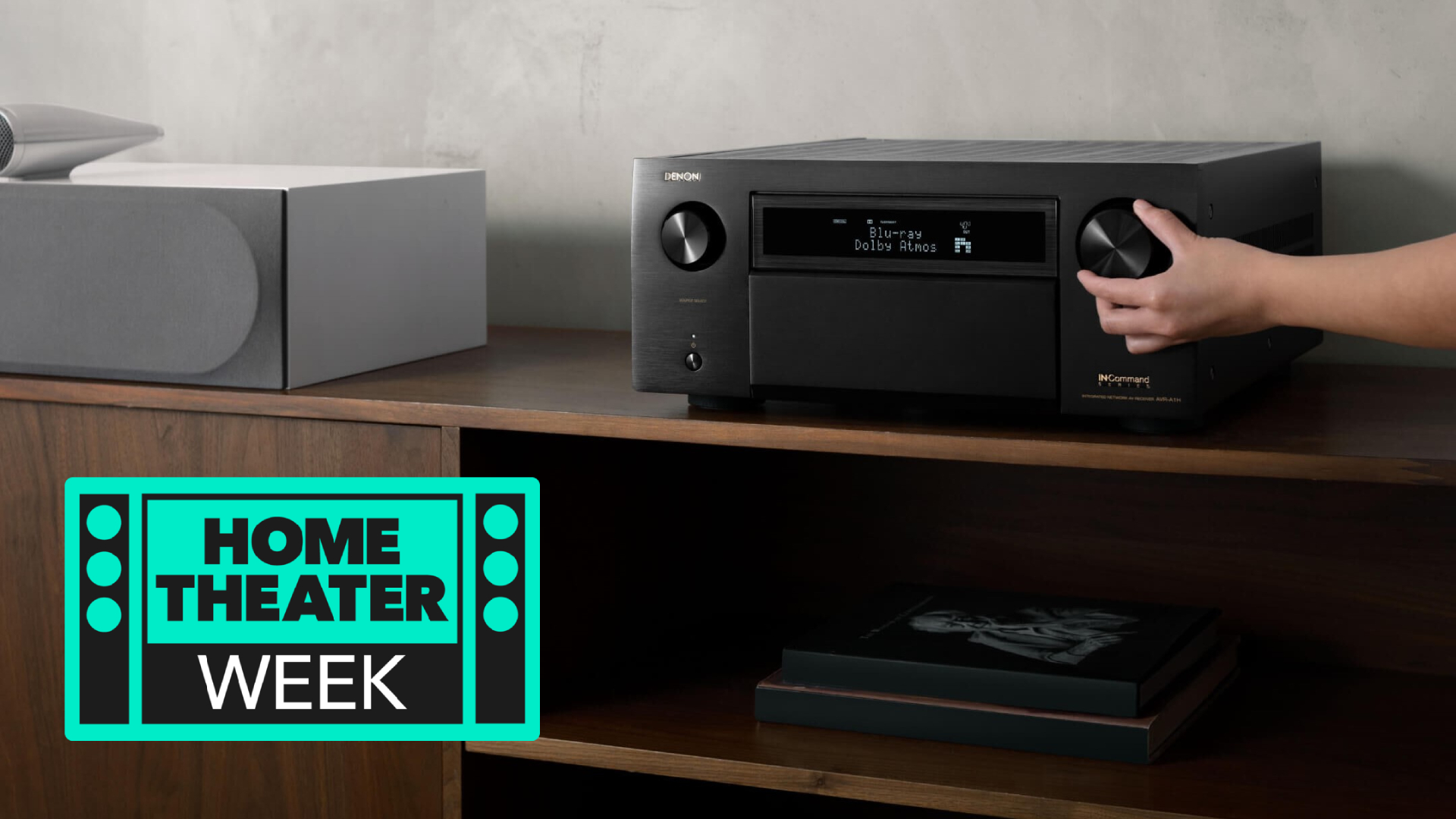Why AV receivers are still the heart of any good home theater
Control central for audio and video

Even in today’s streaming world, the humble AV receiver remains the crucial quarterback on any serious home theater team. Yes, it’s true that the best soundbars and best wireless speakers have advanced hugely, but getting a legitimately cinematic and immersive experience from a home theater setup still requires something more, and for that plus true system flexibility and expandability, an AVR is a must.
The best AV receivers combine four functions in one convenient component: multiple amplifier channels to power from as few as five to as many as fifteen speakers; a surround decoder to extract those multiple channels from the source, whether discs or streaming; and a control section that selects and routes programming from your sources (4K Blu-ray player, TV/eARC, streaming devices) to the various speakers and to your TV or projector. Finally, the “receiver” part — the “R” in AVR — encompasses the diminishingly important radio tuner.

All the channels
Dolby Atmos and DTS:X are the current de facto surround-sound standards, though Atmos is more widespread both on disc and streaming. The two perform similarly. Both exploit multiple speakers in front, to the sides, and behind and above the audience to create a virtual acoustic that pulls viewers ever more fully into the experience up on screen. And both are “scalable,” meaning they adapt their presentation to however many speakers are placed in and around the viewing area, from as few as 3 to as many as 11 or even more so your system can grow with you.
Contemporary AVRs can first be categorized by how many loudspeakers they can power. Serious home theater layouts always include left, center, and right front channels that convey the on-screen dialogue, music, and the lateral sounds that set the scene, plus a pair of surround-channel speakers for the envelopment crucial to so many movie soundtracks. Add in a subwoofer to reinforce the lowest rumbles and deepest musical bass and you get the basic “5.1” home-theater layout, the “point-one” denoting the sub. Every current AVR can deliver 5.1 channels, and the vast majority add at least two more, usually labeled “surround-back” for 7.1.
AVRs that sport the Dolby Atmos and DTS:X labels add “height” channels, either two or four (or, occasionally, more: remember, “scalable”) that introduce a vertical dimension to the bubble of sound enveloping the audience. These may be reproduced by flush-mount ceiling speakers, down-tilting ones located up at wall/ceiling junctures, or up-firing “ceiling-bounce” speakers placed atop the front left/right and surround speakers. Such layouts are dubbed 5.1.2 and 5.1.4, the last digit denoting the number of height or “elevation” speakers. (Or when surround-back speakers are present, 7.1.2 or 7.1.4.) Some top-line AVRs include the ability to connect, and integrate, not one but two subwoofers: e.g., a 7.2.4-channel receiver.
Decoding decoders
As mentioned, almost all today’s AVRs can decode Dolby Atmos and DTS:X, the best-available surround technologies. These “object-oriented” surround modes adapt to the channels and speakers present in the system, steering sound elements to achieve the best possible effect. All such AVRs also have “fallback” modes for content encoded in earlier surround modes such as Dolby Digital and DTS 5.1. There are other modes, primarily IMAX and Auro-3D, that add their own flavorings to the underlying Dolby or DTS decoding processes, but these are usually found only on higher-end receivers.

HDMI matters
HDMI (High-Definition Multimedia Interface) carries both digital video and audio, as well as control signals, making for a convenient, one-cable interconnect between sources, AVRs, and TVs. Almost any AVR conveniently provides more HDMI inputs than your TV, and they will also have an HDMI ARC (Audio Return Channel) output that can receive sound originating from a connected TV’s broadcast or streaming channels. Many midrange-and-up models will feature two HDMI outputs, which allows for the connection of a second, independent zone display.
Sign up for breaking news, reviews, opinion, top tech deals, and more.
The HDMI standard has evolved over the past decade, and as a result there are important nuances when it comes to HDMI connections. The latest version, HDMI 2.1, is the only one with sufficient bandwidth to pass-through 8K video (unimportant now, but a future upgrade) and the 120Hz and variable refresh rate video that are cornerstones of next-gen gaming. Most, but not all, new AVRs include HDMI 2.1 ports, but not every model will support 2.1 bandwidth for every input.
Next comes video processing. Most AVRs can up-convert standard-definition video to a high-definition format, and most can also up-scale video to 4K. A few higher-end receivers can even up-scale to 8K! Most receivers also pass through Dolby Vision and other high-dynamic-range video formats, but there are exceptions, so HDR support is important to note when reviewing a receiver’s specs.

Streaming: music and more
Nearly all current AV receivers incorporate at least some streaming features. Most include both a wired Ethernet network port and on-board Wi-Fi for linking to your home’s internet. Either of these will enable audio streaming via Spotify-Connect and Tidal-Connect, as well as Airplay 2 or Chromecast. Most receivers also have control apps for music streaming from a range of popular services, and some support high-res audio streaming as well.
Room EQ and “smart” sound
One of the most powerful AVR features is automatic room/speaker equalization. Typical systems employ a small, supplied microphone to analyze the true output of your speakers in your room, and then create equalization filters to produce the most accurate real-world response. The key aspect of this is compensation for acoustical “room modes” — strong frequency response peaks and dips determined by the room’s dimensions that can negatively impact the sound you hear. The most sophisticated such systems are provided by third-party firms, the two best known being Audyssey and Dirac. But several AVR brands have developed proprietary solutions that have also proved very effective.
A related feature, and one that’s similarly enabled by the powerful DSP (digital signal processing) found in recent AVRs, is “smart” volume and equalization control. The best-known of these are Audyssey’s Dynamic Volume and Dynamic EQ, which can make a dramatic difference in the cinematic impact of lower-volume playback. Similar features from Dolby, as well as some proprietary equivalents, are found on some brands and models.
Smart home control: the new AVR frontier
Nearly all new AVRs, except for a few bare-bones models, boast some degree of smart home integration. The most common are Alexa, Google, and Siri, which allow for voice-commands like: “Hey Siri, movie time!” to dim the lights, draw the shades, and power up the TV and AVR. And integration with multiroom ecosystems like HEOS, BluOS, and Sonos (Works with Sonos) is also common on mid-range and high-end models.
you might also like
- How to set up a Dolby Atmos home theater system
- A Perlisten/Dirac home theater
- Welcome to TechRadar’s Home Theater Week 2023
Daniel Kumin has written about video, audio, and music technologies for more than three decades, for numerous major magazines and web destinations, and consults in the AV and other industries. He was originally trained as a composer, in case anyone wants to commission a string quartet.